23 December 2021
How to give constructive feedback to developers and help people accept your feedback positively?

Creating a good quality requires solving problems and exercising our minds to find the best methods or tools. However, after working in IT and non-IT projects alike, I noticed that usually, all the biggest problems start with communication (or rather lack of thereof). Most issues can be caught and solved before they become an avalanche of problems. So why don’t we talk to each other? My guess – we aren’t taught how to give constructive feedback, nor how to accept feedback without getting defensive. Today, I want to share what I’ve learned about feedback, summarised in a few good practices and pointers.
Why bother with communication skills?
Maybe some of you wonder: “Why should I care about communication? I work with code, not other people. We have PMs and BAs to handle The Talk.“
Oh man, this article will dismantle this approach.
The most important part of creating software is working in teams and/or with clients. Those are the people who we should take good care of. Even if not for our socialization needs, it’s for pragmatic reasons: we need to cooperate every day, 5 days a week. It’s better to have a good atmosphere and employee morale that lets you focus on work, and avoid personal dramas.

Why is providing feedback important?
“Ok, so I should talk to people sometimes. Fine, but what about feedback? I just give it once a year. It’s enough. And the client – it’s a client, we don’t give feedback to the client.”
There’s a lot to unpack here. Let’s leave “once a year feedback” and “feedback for the client” for now, I’ll come back to both later. For now, let’s focus on times we actually give feedback.
You provide frequent feedback on a daily basis, even without realizing it. Programmers do code reviews, QAs comment on tickets, BAs work on refining tickets, and PMs work on keeping the process going, etc. Each of these actions is, more or less, a feedback action.
Acknowledge your soft skills and be helpful to your colleagues and clients. Constructive feedback example
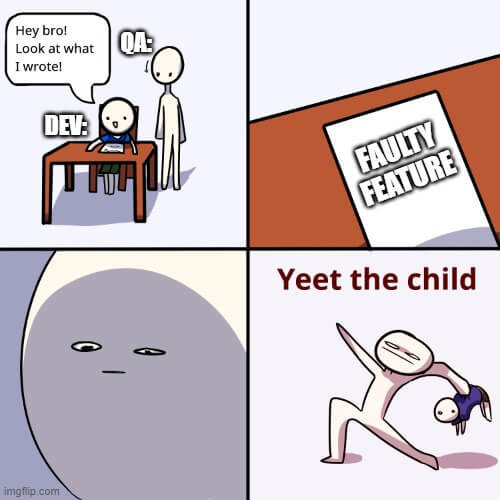
For Quality Assurance specialists like myself, the most common situation to give my other team members meaningful feedback is when I find a possible improvement or a bug in the app they work on.
Of course, nobody forces me to be detailed here. I can just create a ticket and that’s it – it’s the developer’s problem now. Yet, in my opinion, it’s more beneficial to dig deeper. Not only for the app’s desired outcome, and overall performance, but also for the other person, their hard work, confidence, and professional development.
How do I do this? QA vs devs
I always make sure to give more attention to the developer who had worked on the app and ask what was their take. Why does the application work this way? Was this an improvement for the current performance, or just a simple bug?
My general rule: during this conversation, I always want to be on the same page, so I relate to the facts and results of the developer’s work. I gather key information about the situation at hand so I can offer help, provide suggestions, and actionable advice. In short – I deliver constructive feedback about the FEATURE.
Okay, we discussed the situation together (always in a respectful manner!) and we established that it was an improvement. That usually means that QA or/and the developer need to talk to the business analytics, project managers, or even the client and suggest changes. And yet again, we need to provide them with effective feedback with specific examples identifying weaknesses and their problem-solving options. And if that’s not enough – this time we have to provide constructive feedback to people who have more authority than we do.
I acknowledge that this conversation may be stressful, but with the right communication skills, you’ll do it flawlessly. Remember, stick to the hard facts. Explain how the app works now, why a solution is not the best, and suggest what can be done to change it/improve performance/provide better support/whatever else it needs. If you proceed skillfully with constructive feedback, the client, BA, or PM will surely understand WHY there’s a need for change and will be grateful for the input.
Without constructive feedback, there’s no positive outcome. If you just say “app doesn’t work” or “the new feature is stupid”, without any proposed solutions, you end up in the negative feedback realm. In the best-case scenario, your opinion is only going to be ignored, the worst-case – your standing in the eyes of the rest of the team will plummet.
This QA day-to-day situation shows that in software development we have opportunities to provide constructive feedback to everyone and at any time – ranging from project colleagues to the highest-ranking person on the customer side. This is the reason why EVERYBODY needs to invest in their soft skills, especially giving feedback. So here comes the big question:
What does “constructive feedback” even mean?
From my experience, “feedback” is one of the most misused words. You start working and suddenly you’re receiving feedback, giving feedback, clients and bosses are waiting for your feedback on one matter or another. So you give your best shot and try to deliver.
However, how many of us were taught how to give constructive feedback? Or were even taught any constructive feedback examples before we got sucked into the feedback sinkhole?
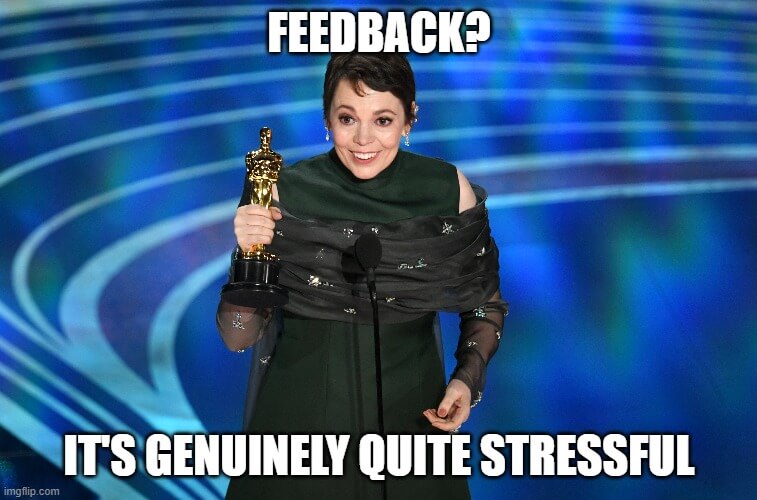
First of all, I would like to give you my definition of “constructive feedback” that I believe is the most adequate. To say that feedback is really positive feedback all of the conditions should be met:
- Relate to the results, attitude, or invested effort towards the situation, or action and NOT the person;
- Be given with good intentions and appreciative tone, hoping that the other party will gain knowledge and improve skills;
- Be given as often as needed to stimulate positive behaviors, whether it’s a few times a day or once a year;
- Be provided by anybody that has something constructive to share.
Secondly, this definition points out behaviors that are not considered feedback, but often mistakenly understood as one:
- giving an opinion about a person based on personal information is an evaluation;
- saying harsh things with no good intentions or improvement pointers is a criticism;
- answering questions is providing information.
So if you provide “negative feedback”, you’ll only get negative behaviors and consequences.
With all of the above in mind, how about we take a closer look at each point and I’ll explain why they are so important.
1. Going personal is going nowhere. Focus on the situation
Often when we think about feedback, we start thinking about what’s our attitude towards a person. Do I like them, or not? What bugs me about them? Human nature at its “finest” but we must apply some emotional intelligence and be better than that.
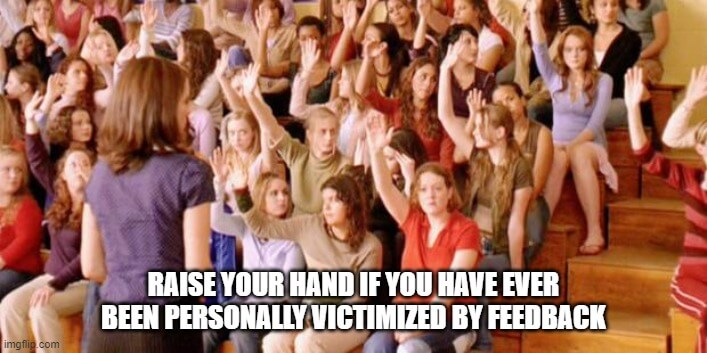
Emotions are going to be present, it’s only natural to feel them. You should always focus on THE SITUATION that you didn’t like or that bugged you that led to your current feelings about the person involved. Feedback shouldn’t focus on personal likes or dislikes but on facts.
I learned that before I go and pour my heart out to another person, it’s good practice to think about “why” as much as I think of “what”, e.g.
- “Why did this person act like that?”
- “Why did they make this particular decision?”
- “Why didn’t they propose other solutions?”
- “Why did this situation happen?”
If you stop and think about other perspectives you might notice that the situation is not as simple as you thought. This is where good communication skills and constructive feedback jump in. You don’t want the situation to happen again, so the “let’s forget about it” option is not on the table. After all, you don’t want to break your relationship with the person.
In my opinion, the best solution here is using the “I” communication method.
The “I” method
…means broadcasting the message from your own perspective. With this method, you can talk about your emotions, observations, and how the situation affected you and your work. This way, the feedback interlocutor doesn’t feel personally attacked by your words, nor feel unappreciated for their hard work, and is more likely to respond in a friendly way to your new perspective. This gives you the possibility to open a discussion and find out all the “whys”.
After you know the reasons, you can give your suggestion or opinion about the whole ordeal. You create a space where you can figure out the solution for the future together, so the situation doesn’t happen again. Or you might change your mind and agree that the reaction was correct but I just missed some crucial information.
You never know what will come out of an honest and deep conversation. You may even build stronger relationships at your workplace!
Some examples of the “I” communication method:
- I’m concerned and struggle to understand what happened today during our morning meetings. Can you tell me why you reacted this way, please? Have I missed something? It’s really important to me because I want to avoid such situations in the future.
- I feel like I can’t rely on you lately as much as I used to. Is anything wrong? Can I help you somehow?
- Sometimes I have problems with getting information from you when things are urgent. Can you tell me the best ways to contact you in critical situations? Which medium is the best for you to answer soon as possible?
2. The difference between feedback and criticism
Maybe you got “feedbacked” yourself but all you could feel afterward was your self-esteem and motivation dropping? Something like:
- “This is the worst piece of code I’ve ever seen”,
- “You don’t know how to lead a meeting, so maybe you shouldn’t do it in the future”,
- “Those improvements you added are completely useless”.
Great job, those are just hurtful words, that don’t clarify anything nor bring anybody closer to solving the problem. And of course, you don’t know what to do to improve your work and how to go forward. That’s why it’s not “feedback” but criticism.
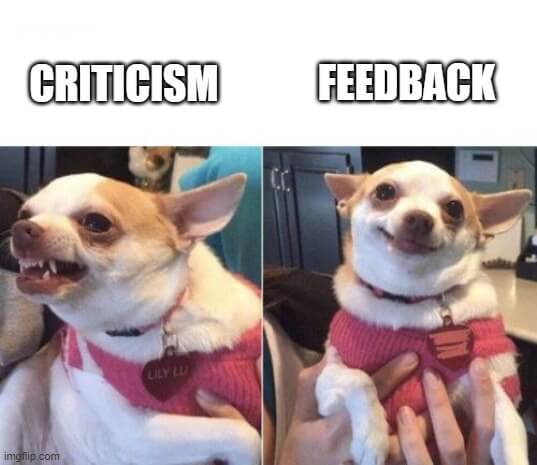
It’s very important to distinguish the two if we want to communicate better to keep your relationships in good shape.
The main goal of constructive feedback is to improve the skills of a recipient and benefit their progress. Criticism is focusing on pointing out what’s bad in a person or/and one’s behavior with no productive guidance.
When you want to give feedback that will be well received by the other party, you need to focus not only on how you want to give it (the right tone) but what you want to say as well. I will emphasize that feedback should focus on open conversation, clearly described situations and facts. It’s a good idea to leave some room for the recipient to elaborate and explain their position.
The “Start, stop, continue” method
In order to distinguish meanness from feedback, personally, I recommend the “start, stop, continue” method, often used during retro meetings. It provides information about what was missed, what won’t be missed, and what was well-received. It’s an awesome replacement for the old “sandwich technique” (wrapping critique in praise) that I believe should finally be eaten and disappear from the feedback arsenal. I don’t know who thought criticism is motivating…
Start, stop, continue constructive feedback examples:
- Start: “I would like to see you taking more tasks concerning API tests. I feel this is a good opportunity for you to strengthen your skills and learn new tools.”
- Stop: “I lack some descriptions in the tickets you create. We were unable to finish one of your tasks during your sick leave, as we had no information about what exactly we’re supposed to do.”
- Continue: “I appreciate how you always give me feedback on my performance when I complete a ticket. It helps me understand what I need to improve and results are showing on my yearly evaluation.”
3. How often is too often?
There’s no limit on feedback! As opposed to periodic assessment, feedback can be provided as often as needed. I admit, this description is a bit vague, so let’s narrow it down.
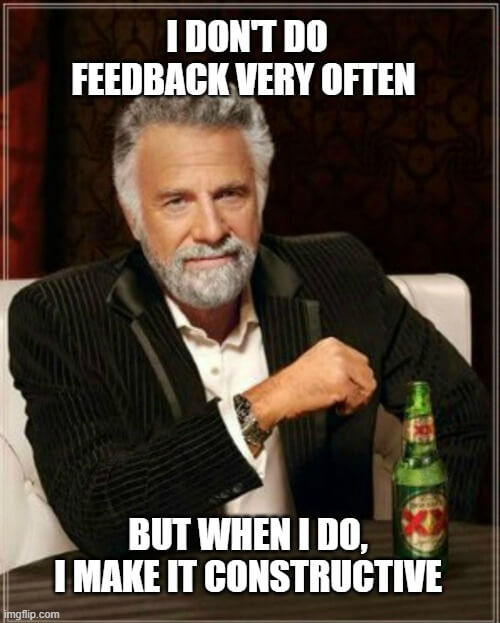
You have a coworker who forgets about detailed descriptions in tickets. Annoying, but at the same time, it happens to the best of us. However, incomplete information causes problems, so you need to let them know. After all, how can they know there’s a problem in the first place if nobody tells them? You quickly agree that they will add descriptions from now on, everybody is happy, the end… Until you find another ticket with no description the next day. OMG, no way. Should you address the issue again?
In this kind of situation, I try to use my common sense and empathy and put myself in my coworker’s shoes. I gave my feedback yesterday, so maybe there wasn’t enough time for them to adjust and implement my suggestions? If I gave my feedback again today, I think it would be too much too soon. Yet, if this happens again in a week or month, it’s definitely good to remind my colleague about our conversation and agreement.
To sum up, I believe that you should give the feedback’s recipient some time to think and adjust to the new ideas. Some can snap their fingers and change like that, others need space to identify mistakes, implement comments, and feel confident with these novelties. While discussing complicated issues use your common sense and think about the feelings of others.
4. Can I give you some feedback?

If I was repeating the same mistakes, I would like to know about them so I can improve. I expect other people to have the same point of view, even though I know not everybody does.
Do you feel like you’re not good enough to give feedback? How can you tell your team leader that they need to improve their leadership skills? Or your client that they need to change priorities and focus on the app’s stabilization and not further development? How can we say to our colleague, who has more experience, that their solution is outdated and not really optimized?
I know it sucks but at the same time, if something is needed, speak up.
People are people, and we make mistakes, and overlook things, no matter how experienced, knowledgeable, or important in the company we are. Smart leaders know it and will appreciate good quality feedback no matter what. Steve Jobs said that “it doesn’t make sense to hire smart people and then tell them what to do. We hire smart people so they can tell us what to do.” Constructive feedback is, first and foremost, a tool to teach and learn from.
The real problem with giving feedback when you don’t feel adequate is not IF you should give it but HOW to do it.
I’ll come back to the aforementioned “I” method. It’s always a good idea to talk about your own feelings and observations, as people aren’t mindreaders to know your emotions. At the same time don’t forget that nobody likes to hear they did something wrong, especially when others are listening. If you want to provide feedback, talk to the person in private. Start a discussion, ask why this situation happened, and hear out the other party. Armed with “why” knowledge, share concerns and comments that help you both deal with the situation. Mostly, these situations even improve the way you’re seen by your coworkers and clients.
Boosting employee’s performance, and other benefits for your company culture
If you put in the effort of making your organization’s feedback constructive, you’ll not only identify problem areas but also achieve a lot of important things:
- Good feedback skills turn employees’ attention towards supportive teamwork, sharing resources, and tips.
- A workmate who can provide information about performance and possible development areas in a friendly and skillful way, have usually better standing in the team and is seen as a team player.
- Employees become comfortable speaking their minds, it’s easier for them to introduce their own ideas and solutions, and are likely to have a positive reaction.
- Even bad information is taken well and accepted faster when feedback is given in a skillful way because it encourages beneficiaries to think about it as good advice and helps in personal development.
- Good feedback can reduce stress by making your colleagues feel that even if they made a mistake, their work is still adequate and good enough. Nobody wants to be talked down but motivated.
- Constructive feedback really can make a day for both recipient and provider, so open communication for the win!
Positive feedback, negative feedback. How about we start giving constructive feedback?
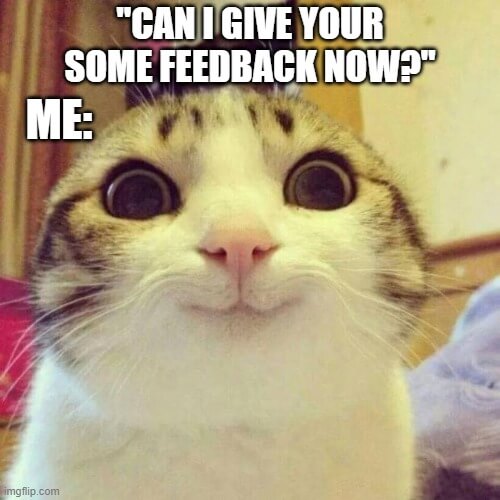
Don’t be afraid to give constructive feedback. It doesn’t matter who’s going to receive it – with a bit of effort you’ll be able to introduce feedback in an approachable way. Remember that the main goal of feedback is providing means for improvement and lifting others up. With a good mindset and attitude, you can really make a difference by being helpful to others.
To make giving feedback easier for you and less stressful for the other party, use softer ways, like the “I” method To give constructive feedback, and not make an evaluation, always put facts over opinions.
Feedback is not always focused on bad things. It’s nice to give or receive good feedback on our performance. It can even be given publicly but try to provide a “to be improved” bit in private, whether it’s on Slack, video chat, or face to face in a separate room.
Most importantly, feedback is a tool to help us and others improve. If you use this mindset and some common sense, constructive feedback will become one of the most powerful and empowering additions to your soft skills toolbox.

